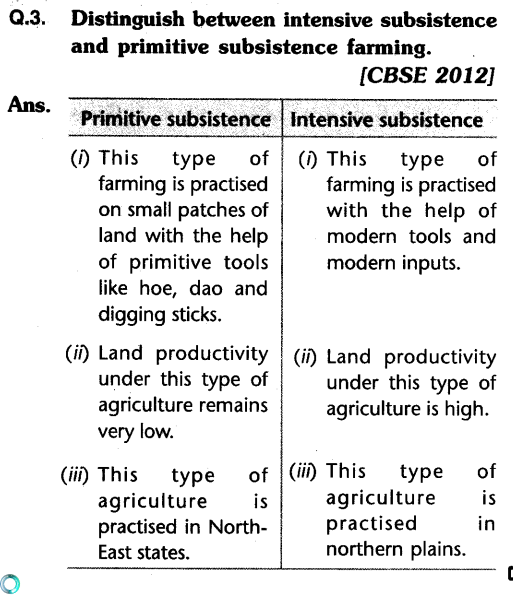Understanding the Influence of Commercial Farming vs Subsistence Farming on Neighborhood Economies
Understanding the Influence of Commercial Farming vs Subsistence Farming on Neighborhood Economies
Blog Article
Exploring the Differences In Between Commercial Farming and Subsistence Farming Practices
The duality in between industrial and subsistence farming techniques is noted by varying purposes, functional ranges, and source use, each with profound implications for both the atmosphere and culture. Industrial farming, driven by revenue and efficiency, often uses innovative technologies that can cause significant environmental concerns, such as soil destruction. On the other hand, subsistence farming highlights self-sufficiency, leveraging standard techniques to maintain household demands while nurturing community bonds and cultural heritage. These different practices increase intriguing inquiries regarding the equilibrium in between economic development and sustainability. How do these different strategies form our world, and what future directions might they take?
Economic Goals
Financial goals in farming methods usually dictate the approaches and scale of operations. In business farming, the primary economic objective is to optimize revenue.
In comparison, subsistence farming is mainly oriented towards fulfilling the immediate needs of the farmer's household, with excess manufacturing being minimal - commercial farming vs subsistence farming. While industrial farming is profit-driven, subsistence farming is centered around sustainability and resilience, reflecting an essentially various set of economic imperatives.

Scale of Procedures
When thinking about the range of procedures,The distinction between business and subsistence farming ends up being specifically apparent. Business farming is characterized by its large nature, commonly encompassing substantial systems of land and utilizing innovative equipment. These procedures are commonly incorporated right into global supply chains, producing huge amounts of plants or livestock meant offer for sale in worldwide and residential markets. The scale of business farming permits for economic situations of range, leading to reduced expenses per device through automation, boosted performance, and the ability to buy technical advancements.
In plain comparison, subsistence farming is normally small-scale, concentrating on creating simply enough food to satisfy the prompt needs of the farmer's household or local area. The land location involved in subsistence farming is often restricted, with less accessibility to modern-day innovation or automation.
Source Application
Source use in farming methods reveals substantial distinctions between commercial and subsistence methods. Commercial farming, defined by massive procedures, commonly uses advanced modern technologies and mechanization to maximize using sources such as land, water, and plant foods. These methods enable boosted effectiveness and higher performance. The emphasis is on making best use of results by leveraging economic climates of range and releasing sources strategically to guarantee consistent supply and earnings. Accuracy agriculture is progressively taken on in business farming, utilizing data analytics and satellite innovation to monitor plant wellness and optimize source application, additional enhancing return and source performance.
In contrast, subsistence farming operates on a much smaller scale, primarily to meet the prompt needs of the farmer's household. Source utilization in subsistence farming is frequently limited by economic restrictions and a reliance on traditional techniques.
Environmental Effect

On the other hand, subsistence farming, practiced on a smaller range, usually employs typical techniques that are more in consistency with the surrounding atmosphere. Plant rotation, intercropping, and organic fertilizing prevail, promoting soil health and wellness and minimizing the requirement for artificial inputs. While subsistence farming generally has a lower environmental footprint, it is not without difficulties. Over-cultivation and inadequate land management can cause dirt disintegration and logging sometimes.
Social and Cultural Ramifications
Farming techniques are deeply linked with the social and cultural textile of communities, influencing and mirroring their values, practices, and economic frameworks. In subsistence farming, the emphasis gets on growing adequate food to fulfill the immediate demands of the farmer's household, often fostering a strong sense of neighborhood and shared duty. Such techniques are deeply rooted in go to the website local traditions, with understanding gave through generations, thereby protecting cultural heritage and enhancing communal connections.
On the other hand, business farming is mainly driven by market needs and success, typically causing a shift towards monocultures and massive procedures. This technique can lead to the erosion of typical farming techniques and social identifications, as local personalizeds and expertise are supplanted by standard, commercial approaches. Furthermore, the emphasis on efficiency and revenue can sometimes lessen the social communication found in subsistence areas, as financial deals replace community-based exchanges.
The duality in between these farming practices highlights the more comprehensive social implications of agricultural choices. While subsistence farming sustains social connection and area connection, industrial see this farming straightens with globalization and financial development, frequently at the expense of standard social structures and multiculturalism. commercial farming vs subsistence farming. Stabilizing these facets remains a vital challenge for lasting agricultural growth
Conclusion
The assessment of business and subsistence farming practices discloses substantial distinctions in objectives, scale, source use, environmental effect, and social effects. Conversely, subsistence farming emphasizes self-sufficiency, using typical methods and neighborhood sources, consequently advertising social preservation and neighborhood cohesion.
The duality in between industrial and subsistence farming practices is marked by differing objectives, operational ranges, and resource utilization, each with profound effects for both the environment and culture. While commercial farming is profit-driven, subsistence farming is focused around sustainability and strength, reflecting an essentially various collection of financial imperatives.
The difference between business and subsistence farming comes to be particularly noticeable when considering the scale of operations. While subsistence farming supports social continuity and neighborhood interdependence, industrial farming straightens with globalization and financial growth, usually at the price of standard social frameworks and cultural diversity.The exam of commercial and subsistence farming practices discloses substantial differences in purposes, scale, resource use, environmental effect, and social effects.
Report this page